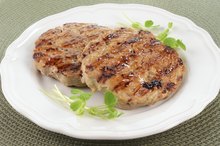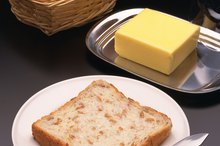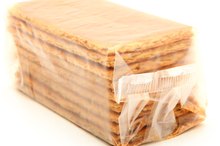The Side Effects of the GFCF Diet
Many parents of children with autism feel that an allergy to gluten -- protein in wheat, barley and rye -- and casein, protein in milk, may be one piece of the puzzle that explains the neurobehavioral symptoms associated with the disorder. Eliminating these foods from the diet, referred to as gluten-free, casein-free, or GFCF, diet reportedly improves autistic symptoms, although clinical studies have not proven a connection. If you're considering the GFCF diet, it's important to be aware of the potential side effects, including effects on bone health, iron deficiency and constipation. Consult your doctor or dietitian before making diet changes.
About GFCF
The GFCF diet aims to eliminate all foods that contain gluten and casein. For gluten, that means no bread, cereal, cracker and pasta products made with wheat, barley or rye flour. Hot dogs, deli meat, sausage, chips, french fries, soups, candy, soy sauce and other packaged goods may also contain gluten. For casein, you need to omit milk, cheese, yogurt and any other food products that may contain milk such as baked goods and chocolate. To meet nutritional needs on a GFCF diet, it's important to include healthy alternatives to the eliminated foods.
- The GFCF diet aims to eliminate all foods that contain gluten and casein.
- For casein, you need to omit milk, cheese, yogurt and any other food products that may contain milk such as baked goods and chocolate.
Bone Health
Wheat Chex Cereal Nutrition Information
Learn More
One of the potential side effects of the GFCF diet is its effect on bone health. Milk and milk products are the primary source of calcium in the American diet, according to the Office of Dietary Supplements. Calcium is an essential nutrient for bone health, and poor intake may affect bone strength. Eliminating milk from the diet increases risk of deficiency. Calcium needs range from 700 milligrams to 1,300 milligrams for children and teens, and 1,000 milligrams to 1,200 milligrams for adults. Including nonmilk sources of calcium such as fortified orange juice or soy milk, calcium-set tofu, canned salmon with bones, or kale is necessary to meet needs and support bone health on a GFCF diet.
- One of the potential side effects of the GFCF diet is its effect on bone health.
- Including nonmilk sources of calcium such as fortified orange juice or soy milk, calcium-set tofu, canned salmon with bones, or kale is necessary to meet needs and support bone health on a GFCF diet.
Iron Deficiency
Wheat, barley and rye are sources of iron, and removing these grains and foods made with them from the diet increases risk of iron deficiency. Iron is necessary for the formation of hemoglobin, which is the protein in your red blood cells that carries oxygen throughout your body. Iron deficiency affects cognition and immune health; in children, it may affect learning. For children and teens, iron needs range from 7 milligrams to 15 milligrams a day, and adults needs 8 milligrams to 18 milligrams. Women of childbearing age -- 19 years to 50 years -- need the higher amounts. It's important to include alternative sources of iron on the GFCF diet such as meat, poultry, beans and broccoli to prevent deficiency.
- Wheat, barley and rye are sources of iron, and removing these grains and foods made with them from the diet increases risk of iron deficiency.
Constipation
Eating Plan for a 15-Year-Old Girl
Learn More
Following the GFCF diet increases risk of constipation. Grains are an important source of fiber, which adds bulk to stool and helps normalize bowel function. Fiber in wheat, specifically the bran in wheat, is more effective at relieving constipation than the fiber in fruits and vegetables, according to the Harvard School of Public Health. You need 14 grams of fiber for every 1,000 calories consumed. In addition to fruits and vegetables, beans and gluten-free grains such as brown rice and quinoa can help you meet your daily fiber needs to improve or prevent constipation.
- Following the GFCF diet increases risk of constipation.
- In addition to fruits and vegetables, beans and gluten-free grains such as brown rice and quinoa can help you meet your daily fiber needs to improve or prevent constipation.
Related Articles
References
- National Institute of Diabetes and Digestive and Kidney Disorders: Celiac Disease
- Office of Dietary Supplements: Calcium
- Office of Dietary Supplements: Iron
- Harvard School of Public Health: Fiber: Start Roughing It!
- Campbell, DB et al. "A Genetic Variant That Disrupts MET Transcription Is Associated with Autism." Proc Natl Acad Sci USA 2006 Nov 7;103(45):16834-9.
- Interview with Carol Ann Brannon, MS, RD, LD, Nutrition Therapist
- Interview with Dr. Cynthia Molloy, M.D., M.S. Assistant Professor of Pediatrics, Center for Epidemiology and Biostatistics, Cincinnati Children's Hospital Medical Center, March 13, 2007.
- Jyonouchi H, Geng L, Ruby A, Zimmerman-Bier B. "Dysregulated Innate Immune Responses in Young Children with Autism Spectrum Disorders: Their Relationship to Gastrointestinal Symptoms and Dietary Intervention." Neuropsychobiology. 2005;51(2):77-85.
- Molloy CA, Manning-Courtney, P. "Prevalence of Chronic Gastrointestinal Symptoms in Children with Autism and Autism Spectrum Disorder." Autism. 2003. 7(2) 165-171.
Writer Bio
Jill Corleone is a registered dietitian and health coach who has been writing and lecturing on diet and health for more than 15 years. Her work has been featured on the Huffington Post, Diabetes Self-Management and in the book "Noninvasive Mechanical Ventilation," edited by John R. Bach, M.D. Corleone holds a Bachelor of Science in nutrition.









